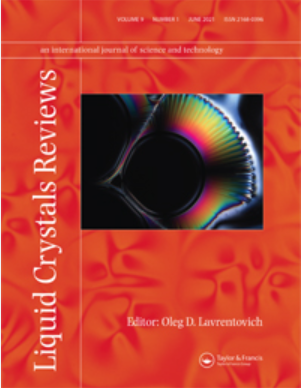平面平行向列液晶中机械纳米化线缺陷组装的操纵
IF 4.2
3区 材料科学
Q2 CHEMISTRY, PHYSICAL
引用次数: 5
摘要
本文章由计算机程序翻译,如有差异,请以英文原文为准。
Manipulation of mechanically nanopatterned line defect assemblies in plane-parallel nematic liquid crystals
Topological line defects are ubiquitous in nature and appear at all physical scales, including in condensed matter systems, nuclear physics, and cosmology. Particularly useful systems to study line defects are nematic liquid crystals (LCs), where they describe singular or nonsingular frustrations in orientational order and are referred to as disclinations. In nematic LCs, line defects could be relatively simply created, manipulated, and observed. We consider cases where disclinations are stabilized either topologically in plane-parallel confinements or by chirality. In the former case, we report on studies in which defect core transformations are investigated, the intriguing dynamics of strength disclinations in LCs exhibiting negative dielectric anisotropy, and stabilization and manipulation of assemblies of defects. For the case of chiral nematics, we consider nanoparticle-driven stabilization of defect lattices. The resulting line defect assemblies could pave the way to several applications in photonics, sensitive detectors, and information storage devices. These excitations, moreover, have numerous analogs in other branches of physics. Studying their universal properties in nematics could deepen understanding of several phenomena, which are still unresolved at the fundamental level.
求助全文
通过发布文献求助,成功后即可免费获取论文全文。
去求助
来源期刊

Liquid Crystals Reviews
CHEMISTRY, PHYSICALCRYSTALLOGRAPHY&n-CRYSTALLOGRAPHY
CiteScore
7.60
自引率
5.90%
发文量
8
期刊介绍:
Liquid Crystals Reviews publishes review articles on all aspects of liquid crystal fundamentals and applied science, including experimental and theoretical studies of physical and chemical properties, molecular design and synthesis and engineering of liquid crystal devices. The Journal fosters cross-disciplinary exchange of ideas, encouraging authors to present material at a level accessible to specialists from other fields of science and engineering. Liquid Crystals Reviews provides the scientific community, in both academia and industry, with a publication of standing, guaranteed by the Editors and by the International Editorial Board who are active scientists in the worldwide liquid crystal community.
 求助内容:
求助内容: 应助结果提醒方式:
应助结果提醒方式:


